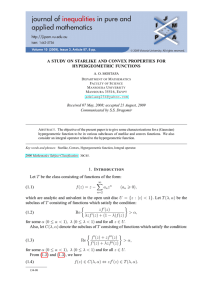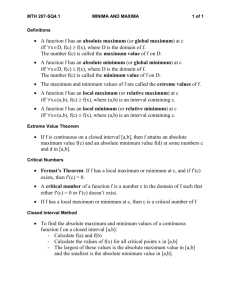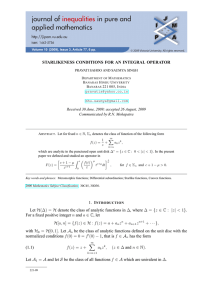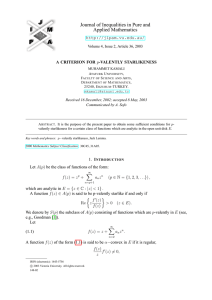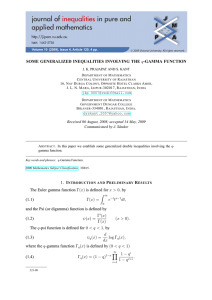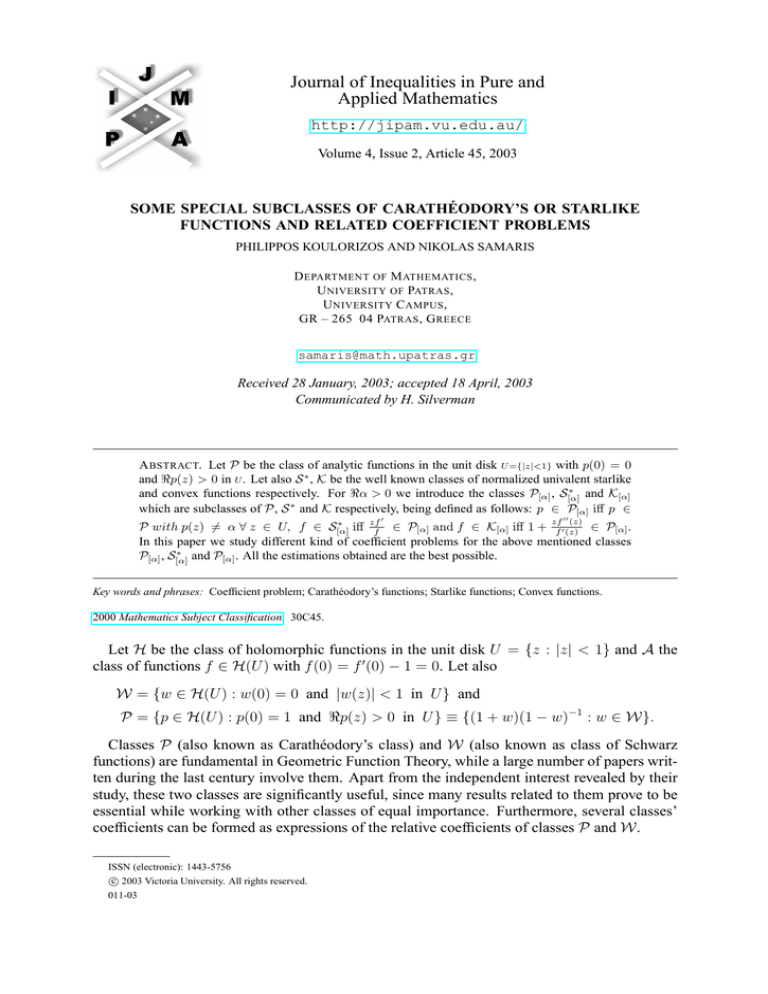
Journal of Inequalities in Pure and
Applied Mathematics
http://jipam.vu.edu.au/
Volume 4, Issue 2, Article 45, 2003
SOME SPECIAL SUBCLASSES OF CARATHÉODORY’S OR STARLIKE
FUNCTIONS AND RELATED COEFFICIENT PROBLEMS
PHILIPPOS KOULORIZOS AND NIKOLAS SAMARIS
D EPARTMENT OF M ATHEMATICS ,
U NIVERSITY OF PATRAS ,
U NIVERSITY C AMPUS ,
GR – 265 04 PATRAS , G REECE
samaris@math.upatras.gr
Received 28 January, 2003; accepted 18 April, 2003
Communicated by H. Silverman
A BSTRACT. Let P be the class of analytic functions in the unit disk U ={|z|<1} with p(0) = 0
and <p(z) > 0 in U . Let also S ∗ , K be the well known classes of normalized univalent starlike
∗
and convex functions respectively. For <α > 0 we introduce the classes P[α] , S[α]
and K[α]
∗
which are subclasses of P, S and K respectively, being defined as follows: p ∈ P[α] iff p ∈
0
00
(z)
∗
P with p(z) 6= α ∀ z ∈ U, f ∈ S[α]
iff zff ∈ P[α] and f ∈ K[α] iff 1 + zff 0 (z)
∈ P[α] .
In this paper we study different kind of coefficient problems for the above mentioned classes
∗
P[α] , S[α]
and P[α] . All the estimations obtained are the best possible.
Key words and phrases: Coefficient problem; Carathéodory’s functions; Starlike functions; Convex functions.
2000 Mathematics Subject Classification. 30C45.
Let H be the class of holomorphic functions in the unit disk U = {z : |z| < 1} and A the
class of functions f ∈ H(U ) with f (0) = f 0 (0) − 1 = 0. Let also
W = {w ∈ H(U ) : w(0) = 0 and |w(z)| < 1 in U } and
P = {p ∈ H(U ) : p(0) = 1 and <p(z) > 0 in U } ≡ {(1 + w)(1 − w)−1 : w ∈ W}.
Classes P (also known as Carathéodory’s class) and W (also known as class of Schwarz
functions) are fundamental in Geometric Function Theory, while a large number of papers written during the last century involve them. Apart from the independent interest revealed by their
study, these two classes are significantly useful, since many results related to them prove to be
essential while working with other classes of equal importance. Furthermore, several classes’
coefficients can be formed as expressions of the relative coefficients of classes P and W.
ISSN (electronic): 1443-5756
c 2003 Victoria University. All rights reserved.
011-03
2
P HILIPPOS KOULORIZOS AND N IKOLAS S AMARIS
Two fundamental examples are given by the classes S ∗ and K, consisting of the univalent
functions f ∈ A which are starlike and convex respectively. It is known that:
f ∈ S ∗ iff f ∈ A and
(1)
zf 0 (z)
∈P
f (z)
and
zf 00 (z)
(2)
f ∈ K iff f ∈ A and 1 + 0
∈ P.
f (z)
The most known subclasses of class P have been initially introduced by the exclusion from
each function’s domain, of an entire surface of the right half-plain {z : <z > 0}. More specifically, we derive the classes Pa and P(a) being defined as follows:
f ∈ Pa iff f ∈ P and <f (z) > a in U, (a > 0)
aπ
and
f ∈ P(a) iff f ∈ P and | arg f (z)| <
in U, (1 > a > 0).
2
∗
If in relation (1) we replace class P by Pa or P(a) , we obtain the classes Sa∗ and S(a)
respectively, known as starlike of order a and strongly starlike of order a. In a similar way, classes Ka
and K(a) known as convex of order a and strongly convex of order a are obtained, applying the
same substitutions in relation (2).
Our idea is to study coefficient problems, about classes which are “very close” to initial
classes P, S ∗ and K, which are obtained excluding from their domains a single point belonging
to the right half-plain {z : <z > 0}. More specifically if <α > 0, we introduce classes P[α] ,
∗
S[α]
and K[α] as follows:
zf 0
∈ P[α]
f
zf 00 (z)
iff 1 + 0
∈ P[α] .
f (z)
∗
P[α] = {f ∈ P : f (z) 6= α, ∀ z ∈ U }, f ∈ S[α]
iff
and f ∈ K[α]
Similar problems, involving class B[a] = {ϕ ∈ H(U ) : |ϕ(z)| ≤ 1, ϕ(z) 6= a, ∀z ∈ U },
(|a| < 1), were studied by Ruud Ermers (see [2]). For B[a] the author gives the best possible
upper bound for the first and second Taylor coefficient, generalizing the relative results provided
by Krzyż (see [3]) for the well known class B[0] .
We also denote
W[a] = W ∩ B[a] .
1+a
If α ≡ 1−a
(|a| < 1) (we will retain this symbolism throughout the paper), then it is easy to see
that
1+w
w ∈ W[a] ⇐⇒
∈ P[α] .
1−w
In order to obtain the Taylor expansions mentioned we will use the forms f (z) = f0 + f1 z +
f2 z 2 + . . . and f −1 (w) = F0 + F1 w + F2 w2 + . . ..
In this paper we give the following results:
(i) For the class P[α] we calculate the quantities max |fn |, n = 1, 2 for <α > 0 and max |f3 |
f
f
for α > 0.
∗
(ii) For the classes S[α]
and K[α] :
(α) we calculate max |f2 | and max |F2 | for <α > 0,
f
f
(β) we solve the Fekete–Szegö problem for every µ ∈ C, determining the quantities
max |f3 − µf22 | and max |F3 − µF22 |,
f
f
J. Inequal. Pure and Appl. Math., 4(2) Art. 45, 2003
http://jipam.vu.edu.au/
S OME S PECIAL S UBCLASSES OF C ARATHÉODORY ’ S . . .
3
(γ) we calculate max |f4 | and max |F4 | for α > 0.
f
f
The following three lemmas will be very useful in order to prove the theorems where our
main results are stated. First we present the Szynal–Prokhorov lemma (see [4]) which is crucial
for the estimation of our results. Through this lemma the value
Φ(x1 , x2 ) = max |w3 + x1 w1 w2 + x2 w13 |
f ∈W
for x1 , x2 ∈ R is obtained. For the formulation of the lemma we will need the following
denotations:
1
− |x1 |,
2
S2 (x1 , x2 ) = 2 − x1 ,
S1 (x1 , x2 ) =
S3 (x1 , x2 ) = 4 − x1 ,
S4 (x1 , x2 ) = x2 + 1,
S5 (x1 , x2 ) = 1 − x2 ,
4
3
(|x1 | + 1) − (|x1 | + 1) ,
S6 (x1 , x2 ) = x2 −
27
2
S7 (x1 , x2 ) = − (|x1 | + 1) − x2 ,
3
1
S8 (x1 , x2 ) = x2 − (x21 + 8),
12
2
S9 (x1 , x2 ) = x2 − (|x1 | − 1),
3
2|x1 |(|x1 | + 1)
S10 (x1 , x2 ) = 2
− x2 ,
x1 + 2|x1 | + 4
2|x1 |(|x1 | − 1)
S11 (x1 , x2 ) = 2
− x2 ,
x1 − 2|x1 | + 4
D1 = (x1 , x2 ) : S1 (x1 , x2 ) ≥ 0, S4 (x1 , x2 ) ≥ 0, S5 (x1 , x2 ) ≥ 0 ,
D2 = (x1 , x2 ) : −S1 (x1 , x2 ) ≥ 0, S2 (x1 , x2 ) ≥ 0, S5 (x1 , x2 ) ≥ 0, S6 (x1 , x2 ) ≥ 0 ,
D3 = (x1 , x2 ) : S1 (x1 , x2 ) ≥ 0, −S4 (x1 , x2 ) ≥ 0 ,
D4 = (x1 , x2 ) : −S1 (x1 , x2 ) ≥ 0, S7 (x1 , x2 ) ≥ 0 ,
D5 = (x1 , x2 ) : S2 (x1 , x2 ) ≥ 0, −S7 (x1 , x2 ) ≥ 0 ,
D6 = (x1 , x2 ) : −S2 (x1 , x2 ) ≥ 0, S3 (x1 , x2 ) ≥ 0, S8 (x1 , x2 ) ≥ 0 ,
D7 = (x1 , x2 ) : −S3 (x1 , x2 ) ≥ 0, S9 (x1 , x2 ) ≥ 0 ,
D8 = (x1 , x2 ) : −S1 (x1 , x2 ) ≥ 0, S2 (x1 , x2 ) ≥ 0, −S7 (x1 , x2 ) ≥ 0, −S6 (x1 , x2 ) ≥ 0 ,
D9 = (x1 , x2 ) : −S2 (x1 , x2 ) ≥ 0, −S7 (x1 , x2 ) ≥ 0, S10 (x1 , x2 ) ≥ 0 ,
D10 = (x1 , x2 ) : −S2 (x1 , x2 ) ≥ 0, S3 (x1 , x2 ) ≥ 0, −S10 (x1 , x2 ) ≥ 0, −S8 (x1 , x2 ) ≥ 0 ,
D11 = (x1 , x2 ) : −S3 (x1 , x2 ) ≥ 0, −S10 (x1 , x2 ) ≥ 0, S11 (x1 , x2 ) ≥ 0 and
D12 = (x1 , x2 ) : −S3 (x1 , x2 ) ≥ 0, −S11 (x1 , x2 ) ≥ 0, −S9 (x1 , x2 ) ≥ 0 .
J. Inequal. Pure and Appl. Math., 4(2) Art. 45, 2003
http://jipam.vu.edu.au/
4
P HILIPPOS KOULORIZOS AND N IKOLAS S AMARIS
Lemma 1. (See [4])
1
|x2 |
Φ(x1 , x2 ) =
Φ1 (x1 , x2 )
Φ2 (x1 , x2 )
Φ3 (x1 , x2 )
if (x1 , x2 ) ∈ D1 ∪ D2 ,
S
if (x1 , x2 ) ∈ 7k=3 Dk ,
if (x1 , x2 ) ∈ D8 ∪ D9 ,
if (x1 , x2 ) ∈ D10 ∪ D11 ,
if (x1 , x2 ) ∈ D12 ,
where:
12
|x1 | + 1
2
,
Φ1 (x1 , x2 ) = (|x1 | + 1)
3
3(|x1 | + 1 + x2 )
2
2
12
x1 − 4
x1 − 4
1
Φ2 (x1 , x2 ) = x2
and
3
x21 − 4x2
3(x2 − 1)
12
2
|x1 | − 1
Φ3 (x1 , x2 ) = (|x1 | − 1)
.
3
3(|x1 | − 1 − x2 )
Lemma 2. For every (x1 , x2 ) ∈ C2 it holds that max |x1 w12 + x2 w2 | = max{|x1 |, |x2 |}.
w∈W
Proof. Let w1 , w2 ∈ C. Applying the Carathéodory–Toeplitz (C–T) Theorem (see [1]) in the
class W, there exists a w ∈ W with w0 (0) = w1 and w00 (0) = 2w2 if and only if
|w1 | ≤ 1 and |w2 | ≤ 1 − |w1 |2 ,
(3)
or equivalently there exist (r1 , r2 ) ∈ [0, 1]2 and |z1 | = |z2 | = 1 such that
w1 = r1 z1 and w2 = (1 − r12 )r2 z2 .
(4)
Using (4) we derive that
max |x1 w12 + x2 w2 |
w∈W
= max |x1 r12 z12 + x2 (1 − r12 )r2 z2 | : 0 ≤ r1 ≤ 1, 0 ≤ r2 ≤ 1, |z1 | = |z2 | = 1
= max |x1 |r12 + |x2 |(1 − r12 ) : 0 ≤ r1 ≤ 1
= max r12 (|x1 | − |x2 |) +|x2 | : 0 ≤ r1 ≤ 1
= max {|x1 |, |x2 |} .
Lemma 3.
(α) If <α > 0 then f ∈ P[α] if and only if it has the form
1 − |a|(p(z)+1) + a(1 − |a|(p(z)−1) )
1 − |a|(p(z)+1) − a(1 − |a|(p(z)−1) )
with p ∈ P.
(β) For (a1 , a2 , a3 ) ⊂ C3 the following propositions are equivalent:
(i) There is a function f ∈ P[α] such that f1 = a1 , f2 = a2 and f3 = a3 .
J. Inequal. Pure and Appl. Math., 4(2) Art. 45, 2003
http://jipam.vu.edu.au/
S OME S PECIAL S UBCLASSES OF C ARATHÉODORY ’ S . . .
5
(ii) There is a function w = w1 z + w2 z 2 + . . . ∈ W such that:
4a log |a|
w1 ,
−1 + |a|2
4a log |a| (−1 + |a|2 + (−1 + 2a − |a|2 ) log |a|) 2
w1 + w2 ,
a2 =
−1 + |a|2
−1 + |a|2
a1 =
a3 =
4a log |a|
2 (−1 + |a|2 − (1 − 2a + |a|2 ) log |a|)
w
+
w1 w2
3
−1 + |a|2
−1 + |a|2
1
3(−1 + |a|2 )2 + 2 log |a|(3 − 3|a|4 + 6a(−1 + |a|2 )
2
2
3(−1 + |a| )
!
+ (1 + 6a2 + 4|a|2 + |a|4 − 6a(1 + |a|2 )) log |a|) w13 .
+
Proof. For the proof of this lemma we consider the following propositions:
(i) f ∈ P[α] if and only if f has the form f =
(ii) f ∈ W[a] if and only if w has the form
w=
1+w
1−w
with w ∈ W[a] .
α − w1
1 − ᾱw1
with w1 ∈ B[0] and w1 (0) = a.
(iii) w1 ∈ B[0] with w1 (0) = a if and only if w1 has the form w1 = a|a|p−1 with p ∈ P.
We now observe that the proof of propositions (i) and (ii) is rather simple. The proof of
proposition (iii) is obtained by relation w1 ∈ B[0] if and only if w1 gets the form w1 = λe−tp
with |λ| = 1, t > 0 and p ∈ P. Setting w1 (0) = λe−t = a we obtain the result of the
proposition.
Thus combining the results of propositions (i), (ii) and (iii) we get the result of the lemma.
Our results are stated in the following theorems.
(α) For <α > 0 it holds that:
Theorem 4.
(i)
max |f1 | = −
f ∈P[α]
4|a| log |a|
1 − |a2 |
and
(ii)
max |f2 |
f ∈P[α]
4a log |a|(−1 − |a|2 (−1 + log |a|) + (−1 + 2a) log |a|) 4a log |a| = max , −1 + |a|2 .
(−1 + |a|2 )2
J. Inequal. Pure and Appl. Math., 4(2) Art. 45, 2003
http://jipam.vu.edu.au/
6
P HILIPPOS KOULORIZOS AND N IKOLAS S AMARIS
(β) For α > 0 it holds that:
max |f3 |
|x31 (a)| Φ1 (x11 (a), x21 (a)) for α ∈ (0, 0.76227] ∪ [1.05537, 1.39636],
|x31 (a)| Φ2 (x11 (a), x21 (a)) for α ∈ [0.76227, 0.883736] ∪ [1.04583, 1.05537],
|x31 (a)| Φ3 (x11 (a), x21 (a)) for α ∈ [0.883736, 0.914114] ∪ [1.03238, 1.04583],
=
|x31 (a)| |x21 (a)|
for α ∈ [0.914114, 1.03238],
|x (a)|
for α ∈ [1.39636, ∞),
31
f ∈P[α]
with:
2 − 1 + a2 − (−1 + a)2 log |a|
x11 (a) =
,
−1 + a2
(−1 + a)2 − 3(−3 + a)(1 + a) log |a| + 2(1 − 4a + a2 )(log |a|)2
x21 (a) =
3(−1 + a2 )2
and
x31 (a) =
4a log |a|
.
−1 + a2
(α) For <α > 0 and µ ∈ C it holds that:
Theorem 5.
(i)
max
|f2 | = −
∗
f ∈S[α]
4|a| log |a|
,
1 − |a2 |
(ii)
|f2 |,
max |F2 | = max
∗
∗
f ∈S[α]
f ∈S[α]
(iii)
max |f2 | = max |F2 | =
f ∈K[α]
f ∈K[α]
1
max
|f2 |,
∗
2 f ∈S[α]
(iv)
max |f3 − µf22 |
∗
f ∈S[α]
2a log |a|(1 − |a|2 + (1 + |a|2 + 2a(−3 + 4µ)) log |a|) 2a log |a| ,
= max −1 + |a|2 ,
(−1 + |a|2 )2
(v)
max |F3 − µF22 | = max
|f3 + (µ − 2)f22 |,
∗
∗
f ∈S[α]
f ∈S[α]
(vi)
max |f3 − µf22 | =
f ∈K[α]
3
1
max
|f3 − µ f22 |
∗
3 f ∈S[α]
4
and
(vii)
max |F3 −
f ∈K[α]
J. Inequal. Pure and Appl. Math., 4(2) Art. 45, 2003
µF22 |
1
3
2
f3 + (µ − 2) f2 .
= max
∗
3 f ∈S[α]
4 http://jipam.vu.edu.au/
S OME S PECIAL S UBCLASSES OF C ARATHÉODORY ’ S . . .
7
(β) For α > 0 it holds that:
(i) max
|f4 |
∗
f ∈S[α]
=
|x32 (a)| |x22 (a)|
for α ∈ (0, 1.02357] ∪ [1.14133, 1.33331]
∪[1.76736, ∞),
|x32 (a)| Φ3 (x12 (a), x22 (a)) for α ∈ [1.02357, 1.03283],
|x32 (a)| Φ2 (x12 (a), x22 (a)) for α ∈ [1.03283, 1.0378] ∪ [1.73905, 1.76736],
|x32 (a)| Φ1 (x12 (a), x22 (a)) for α ∈ [1.0378, 1.14133] ∪ [1.33331, 1.73905],
with:
2(1 − a2 + (1 − 5a + a2 ) log |a|)
,
−1 + a2
6(−1 + 5a − 5a3 + a4 ) log |a|
x22 (a) = 1 −
3(−1 + a2 )2
2(1 + a(−15 + a(40 + (−15 + a)a)))(log |a|)2
+
3(−1 + a2 )2
x12 (a) = −
and
x32 (a) =
4a log |a|
,
3(−1 + a2 )
max |f4 | =
(ii)
f ∈K[α]
(iii) max
|F4 |
∗
f ∈S[α]
|x33 (a)| |x23 (a)|
|x33 (a)| Φ3 (x13 (a), x23 (a))
=
|x33 (a)| Φ2 (x13 (a), x23 (a))
|x (a)| Φ (x (a), x (a))
33
1 13
23
1
max
|f4 |,
∗
4 f ∈S[α]
for α ∈ (0, 0.711625] ∪ [0.824185, 0.936408]
∪[0.983596, ∞),
for α ∈ [0.711625, 0.71718] ∪ [0.977731, 0.983596],
for α ∈ [0.71718, 0.732352] ∪ [0.975309, 0.977731],
for α ∈ [0.732352, 0, 824185] ∪ [0.936408, 0.975309],
with:
2 1 − a2 + (1 + 10a + a2 ) log |a|
x13 (a) = −
,
−1 + a2
6(−1 + a)(1 + a)(1 + a(10 + a)) log |a|
x23 (a) = 1 −
3(−1 + a2 )2
2(1 + a(30 + a(130 + (30 + a)a)))(log |a|)2
+
3(−1 + a2 )2
and
x33 (a) =
J. Inequal. Pure and Appl. Math., 4(2) Art. 45, 2003
4a log |a|
3(−1 + a2 )
http://jipam.vu.edu.au/
8
P HILIPPOS KOULORIZOS AND N IKOLAS S AMARIS
and
max |F4 |
|x34 (a)| |x24 (a)|
|x34 (a)| Φ2 (x14 (a), x24 (a))
=
|x34 (a)| Φ1 (x14 (a), x24 (a))
|x (a)| Φ (x (a), x (a))
34
3 14
24
(iv)
f ∈K[α]
for α ∈ (0, 0.565815] ∪ [0.750011, 0.876173]
∪[0.976968, ∞),
for α ∈ [0.565815, 0.575026] ∪ [0.963576, 0.968213],
for α ∈ [0.575026, 0.750011] ∪ [0.876173, 0.963576],
for α ∈ [0.968213, 0.976968],
with:
2(1 − a2 + (1 + 5a + a2 ) log |a|)
,
−1 + a2
6(−1 − 5a + 5a3 + a4 ) log |a|
x24 (a) = 1 −
3(−1 + a2 )2
2(1 + a(15 + a(40 + (15 + a)a)))(log |a|)2
+
3(−1 + a2 )2
x14 (a) = −
and
x34 (a) =
a log |a|
.
−3(−1 + a2 )
(i) For every f ∈ P[α] , we set the coefficients f1 , f2 and f3 in the form of Lemma 3
(β). Using the relation maxw∈W |w1 | = 1, we find that maxf ∈P[α] |f1 | coincides with the
form given in Theorem 4.
In a similar way, maxf ∈P[α] |f2 | presented in Theorem 4 follows using Lemma 2.
(ii) Using Lemma 3 (β), after the calculations we obtain that
Proof.
max |f3 | = |x31 (a)| Φ x11 (a), x21 (a) .
f ∈P[α]
In order to find for any a ∈ (−1, 1) the corresponding
branch of Φ, we proceed finding
all the roots of each equation Si x1 (a), x2 (a) = 0 (i = 1, . . . , 11), with respect to a,
that belong in (−1, 1). The procedure by which these calculations are obtained will be
described later.
In the next step, we consider the partition of the interval (−1, 1) formed by the above
roots, into successive subintervals, being defined
∀i respectively. Checking in each
subinterval the sign of all Si x1 (a), x2 (a) , through Lemma 1, we select the corresponding branch of Φ to thissubinterval. More specifically we verify that the roots of
all quantities Si x1 (a), x2 (a) belong to the set:
A = {−0.1349, −0.0761, −0.06172, −0.04487, 0.01593, 0.0224,
0.02694, 0.09078, 0.1654, 0.17104, 0.2707}.
J. Inequal. Pure and Appl. Math., 4(2) Art. 45, 2003
http://jipam.vu.edu.au/
S OME S PECIAL S UBCLASSES OF C ARATHÉODORY ’ S . . .
9
Checking the signs of functions Si x1 (a), x2 (a) in the twelve subintervals defined, we
obtain the formulation of the following inequalities:
S1 ≥ 0
S2 ≥ 0
S3 ≥ 0
S4 ≥ 0
S5 ≥ 0
S6 ≥ 0
S7 ≥ 0
S8 ≥ 0
S9 ≥ 0
S10 ≥ 0
S11 ≥ 0
iff a ∈ [0.17104, 0.27070],
iff a ∈ [0.09078, 1),
iff a ∈ (−1, −0.07610] ∪ [0.03902, 1),
iff a ∈ (−1, 0.10256] ∪ [0.16413, 1),
iff a ∈ [0.03220, 1),
iff a ∈ [0.16540, 1),
iff a ∈ [0.17550, 0.22472],
iff a ∈ [−0.04027, 0.01306],
iff a ∈ (−1, −0.25267] ∪ [−0.04487, 0.01593] ∪ [0.44174, 1),
iff a ∈ (−1, −0.13490] ∪ [0.02694, 1) and
iff a ∈ (−1, −0.06172] ∪ [0.02240, 1).
In this way we also get for every function Si , the set of a ∈ (−1, 1) with Si (x1 (a), x2 (a)) <
0. Therefore by Lemma 1 we obtain the result given in part (ii) of Theorem 4, which
completes the proof of the theorem.
It only remains to solve the equations Si (x1 (a), x2 (a)) = 0. In the following paragraphs, we
outline our methodology for the solution of these equations. But first let us stress that although
we will use a numeric computation program like Mathematica, its use will be restricted only to
the following cases:
(i) once we have rigorously proved that a given function of a single real variable has a
unique root in a given closed interval then, we will compute this root by Mathematica,
(ii) given a polynomial of a single variable, we will use Mathematica to compute the k roots
of it and
(iii) we will use Mathematica to perform both numeric and symbolic algebraic calculations
that can, in principle, be performed by hand.
Replacing in the initial equation all the expressions of the form |Π| with ±Π, we form all
possible combinations, deriving some equations of the form
Q(t) = Q0 (t) + Q1 (t) log |t| + · · · + Qk (t) (log |t|)k = 0,
with Qi i = 0, . . . , k rational functions of a single real variable t. Therefore, it suffices to solve
the new equations and then check which of their roots are also roots of the original one (we call
k the logarithmic degree of Q(t) – in our case k = 3).
By dividing with Qk (t), we may further suppose that the maximum logarithmic degree coefficient Qk (t) is constantly 1 (this step requires a check whether any root of Qk is also a root of
the whole equation). Therefore, we now have to deal with an equation of the form
k−1
k
Q(t) = Q0 (t) + Q1 (t) log t + · · · + Qk−1 (t) log t
+ log t = 0.
Our crucial observation now is that if we differentiate Q(t), we obtain a function of the same
form, but with its logarithmic degree decremented by one (and possibly with a non-constant
k−1
coefficient for log t
). Assume that we have computed the roots of the latter equation of
logarithmic degree k − 1. Then we can locate the (closed) intervals where the original Q(t) is
either strictly increasing or strictly decreasing. In such an interval, Q(t) can have at most one
root. We can easily determine if at this interval Q(t) has a unique root or no root at all. In case
it has a unique root, we compute it using Mathematica.
These remarks lead to the following recursive computation of the roots of Q(t). Differentiate
repeatedly and between any two differentiations divide with the maximum degree coefficient,
J. Inequal. Pure and Appl. Math., 4(2) Art. 45, 2003
http://jipam.vu.edu.au/
10
P HILIPPOS KOULORIZOS AND N IKOLAS S AMARIS
until a function with no logarithms (of logarithmic degree 0) is obtained. This obviously is a
rational function. Find its roots by the use of Mathematica. Then backtrack step by step to the
original function using the strict monotonicity intervals at each step to locate the intervals where
the function of the previous step has a unique solution. Then find the roots of the previous step
by Mathematica and proceed further back to larger logarithmic degree, until the original function is reached and all of its roots are computed. This ends the description of our methodology
for the solution of Si (x1 (a), x2 (a)) = 0 and completes the proof of the theorem.
Remark 6. For a ∈ (−1, 1) we remark that:
(i) For a → 1 (equivalently α → 0) then maxf ∈P[a] |fk | → 2, k = 1, 2, 3.
(ii) For a → −1 (equivalently α → ∞) then maxf ∈P[a] |fk | → 2, k = 1, 2, 3.
These remarks are making obvious that our theorem consists an extension of Carathé
-odory’s inequality in the cases i = 1, 2, 3. In Figures 1 – 3 we give the graphical
representations of maxf ∈P[α] |fk | as functions of a, for k = 1, 2, 3 respectively.
2
1.5
1
0.5
-1
-0.5
0.5
1
Figure 1:
We also remark that:
∗ |fn | → n, n = 2, 3, 4.
(iii) For a → ±1 then maxf ∈S[a]
(iv) For a → ±1 then maxf ∈K[a] |fn | → 1, n = 2, 3, 4.
Remarks (iii) and (iv) are pointing out that our theorem consists as well an extension of
Rogosinski’s inequality (see [5]), in the cases i = 2, 3, 4, for starlike or convex functions re∗ |fn |, as functions of a for n = 2, 3, 4, are
spectively. The graphical representations of maxf ∈S[α]
given in Figures 4 – 6 respectively.
∗
Proof of Theorem 5. A function f ∈ S[α]
⇐⇒
2
and q := 1 + q1 z + q2 z + . . . . Since
zf 0
f
≡ q ∈ P[α] while f := z+f2 z 2 +f3 z 3 +. . . ,
1
1
f2 = q1 , f3 = (q2 + q12 ) and f4 = (q13 + 3q1 q2 + 2q3 ),
2
6
J. Inequal. Pure and Appl. Math., 4(2) Art. 45, 2003
http://jipam.vu.edu.au/
-1
S OME S PECIAL S UBCLASSES OF C ARATHÉODORY ’ S . . .
11
2
1.5
1
0.5
-1
1
-0.5
0.5
1
0.5
1
Figure 2:
2
1.5
1
0.5
-1
-0.5
fig
3.
Figure 3:
expanding f to Taylor series and substituting quantities q1 , q2 and q3 with their form described
in Lemma 3, we obtain that:
4a log |a|
w1 ,
−1 + |a|2
2
2a log |a|
2
2
2
f3 =
(−1
+
|a
|)w
+
−1
+
|a
|
+
(−1
+
6a
−
|a
|)
log
|a|
w1
2
(−1 + |a2 |)2
f2 =
J. Inequal. Pure and Appl. Math., 4(2) Art. 45, 2003
http://jipam.vu.edu.au/
.5
12
P HILIPPOS KOULORIZOS AND N IKOLAS S AMARIS
2
1.5
1
0.5
-1
-0.5
0.5
1
-1
Figure 4:
3
2.5
2
1.5
1
0.5
1
-1
-0.5
0.5
1
Figure 5:
and
4a log |a| 2 2
2
2
2
f4 =
3(−1
+
a
)
w
−
6(−1
+
a
)
1
−
a
+
(1
−
5a
+
a
)
log
|a|
w1 w2
3
9(−1 + a2 )3
+(3(−1+a2 )2 −6(−1+5a−5a3 +a4 ) log |a|+2(1−15a+40a2 −15a3 +a4 )(log |a|)2 )w13 .
2
∗ |f2 |, maxf ∈S ∗ |f3 − µf | and maxf ∈S ∗ |f4 |, are derived following the proQuantities maxf ∈S[α]
2
[α]
[α]
cedure of the previous theorem.
J. Inequal. Pure and Appl. Math., 4(2) Art. 45, 2003
http://jipam.vu.edu.au/
-0.
S OME S PECIAL S UBCLASSES OF C ARATHÉODORY ’ S . . .
13
4
3
2
1
-1
-0.5
0.5
1
Figure 6:
For the inverse function F ≡ f −1 it holds that:
F2 = −f2 , F3 = 2f22 − f3 and F4 = −5f23 + 5f2 f3 − f4 .
∗ |F4 |, since maxf ∈S ∗ |F2 |
It is obvious that the most complicated case is the calculation of maxf ∈S[α]
[α]
2
∗ |F3 − µF | are derived straightforwardly. Substituting f2 , f3 and f4 in F4 , we oband maxf ∈S[α]
2
tain a polynomial expression with respect to w1 , w2 and w3 . We work in a similar way with the
calculation of maxf ∈P[α] |f3 | to complete the proof.
Furthermore, due to the initial assumption of this paper, a function g ∈ K[α] ⇐⇒ 1 +
zg 00
≡ q ∈ P[α] with g := z + g2 z 2 + g3 z 3 + . . . and q := 1 + q1 z + q2 z 2 + . . . . Now let
g0
∗
S[α]
3 f := z + f2 z 2 + f3 z 3 + . . .. It can be easily seen that:
f2
f3
f4
, g3 =
and g4 = ,
2
3
4
which renders the proof of (α) (iii), (vi), (vii) and (β) (ii) straightforward. In order to prove (β)
∗ |f4 |.
(iv), we work in the same manner with the calculation of maxf ∈P[α] |f3 | and maxf ∈S[α]
g2 =
R EFERENCES
[1] C. CARATHÉODORY, Über den Variabilitätsbereich der Koeffizienten von Potenzreihen die
gegebene Werte nicht annehmen, Math. Ann., 64 (1907), 95–115.
[2] R. ERMERS, Coefficient estimates for bounded nonvanishing functions, Wibro Dissertatidrukkerij,
Helmond 1990, Koninklijke Bibliotheek Nederland, Holland.
[3] J.G. KRZYZ, Problem 1, posed in: Fourth Conference on Analytic Functions, Ann. Polon. Math.,
20 (1967-68), 314.
[4] D.V. PROKHOROV AND J. SZYNAL, Inverse coefficients for (α, β)–convex functions, Annales
Universitatis Mariae Curie - Sklodowska, X 15 (1981), 125–141.
[5] W. ROGOSINSKI, On the coefficients of subordinate functions, Proc. London Math. Soc., 48 (1943),
48–82.
J. Inequal. Pure and Appl. Math., 4(2) Art. 45, 2003
http://jipam.vu.edu.au/



